 W
WCapra is a genus of mammals, the goats, composed of up to nine species, including the markhor and many species known as ibexes. The domestic goat is a domesticated species derived from the wild goat. Evidence of goat domestication dates back more than 8,500 years.
 W
WThe Alpine ibex, also known as the steinbock, bouquetin, or simply ibex, is a species of wild goat that lives in the mountains of the European Alps. It is a sexually dimorphic species: males are larger and carry longer, curved horns than females. Its coat colour is typically brownish grey. Alpine ibex tend to live in steep, rough terrain near the snow line. They are also social, although adult males and females segregate for most of the year, coming together only to mate. Four distinct groups exist; adult male groups, female-offspring groups, groups of young individuals, and mixed-sex groups.
 W
WThe bezoar ibex is a wild goat subspecies that is native to the montane forested areas in the Caucasus and the Zagros Mountains.
 W
WThe Bukharan markhor, or Tadjik markhor is an endangered goat-antelope, native to Tajikistan, Turkmenistan and Uzbekistan, possibly also Afghanistan. Today it is found in few scattered populations, for example in Kugitang Nature Reserve in easternmost Turkmenistan. The population of the Bukharan markhor is at around 5,750 animals.
 W
WThe East Caucasian tur, also known as the Daghestan tur, is a mountain-dwelling caprine found only in the eastern half of the Greater Caucasus mountains, in Azerbaijan, Georgia, and European Russia. The East Caucasian tur lives in rough mountainous terrain, where it eats mainly grasses and leaves, and is preyed upon by steppe wolves, lynxes, and possibly Syrian brown bears and Persian leopards. It is sometimes considered a subspecies of the West Caucasian tur, and sometimes as a full species in its own right. The species is listed as near threatened by the IUCN.
 W
WThe domestic goat or simply goat is a domesticated species of goat-antelope typically kept as livestock. It was domesticated from the wild goat of Southwest Asia and Eastern Europe. The goat is a member of the animal family Bovidae and the subfamily Caprinae, meaning it is closely related to the sheep. There are over 300 distinct breeds of goat. It is one of the oldest domesticated species of animal, according to archaeological evidence that its earliest domestication occurred in Iran at 10,000 calibrated calendar years ago.
 W
WThe Iberian ibex, also known as the Spanish ibex, Spanish wild goat, or Iberian wild goat, is a species of ibex endemic to the Iberian Peninsula. Four subspecies have been described; two are now extinct. The Portuguese subspecies became extinct in 1892, and the Pyrenean subspecies became extinct in 2000. A project to clone to the Pyrenean subspecies resulted in one clone being born alive in July 2003, making it the first taxon to become "un-extinct", although the clone died a few minutes after birth due to physical defects in its lungs, therefore remaining extinct.
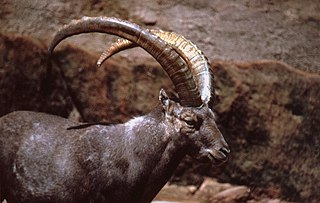 W
WAn ibex is any of several species of wild goat , distinguished by the male's large recurved horns, which are transversely ridged in front. Ibex are found in Eurasia, North Africa, and East Africa. The name ibex comes from Latin, borrowed from Iberian or Aquitanian, akin to Old Spanish bezerro "bull", modern Spanish becerro "yearling". Ranging in height from 27 to 43 inches and weighing 200 to 270 pounds, ibex can live 20 years. Two closely related varieties of goats found in the wild are not usually called ibex: the markhor and the feral goat.
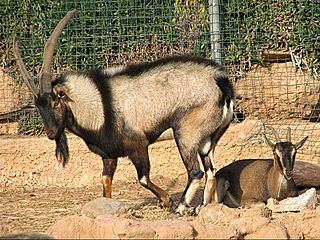 W
WThe kri-kri, sometimes called the Cretan goat, Agrimi, or Cretan Ibex, is a feral goat inhabiting the Eastern Mediterranean, previously considered a subspecies of wild goat. The kri-kri is now found only on the island of Crete, Greece and three small islands just offshore.
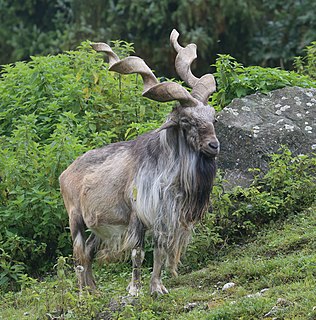 W
WThe markhor is a large Capra species native to Central Asia, Karakoram and the Himalayas. It is listed on the IUCN Red List as Near Threatened since 2015.
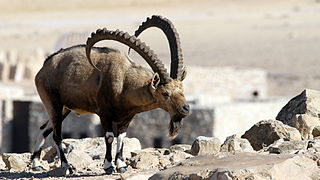 W
WThe Nubian ibex is a desert-dwelling goat species found in mountainous areas of northern and northeast Africa, and the Middle East. It was historically considered to be a subspecies of the Alpine ibex, but is now considered a distinct species. The wild population is estimated at 1,200 individuals.
 W
WThe Portuguese ibex is an extinct subspecies of Iberian ibex that inhabited the north mountainous zones of Portugal, Galicia, Asturias and western Cantabria. In size and colouration it was much like the Spanish animals, though inclining towards brown rather than black markings. Its horns were strikingly different from any of the other Iberian subspecies. They were only half the length of the Pyrenean ibex, but were almost twice as wide, and, consequently, much closer together at their base.
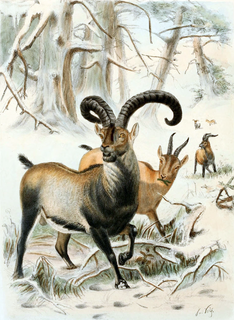 W
WThe Pyrenean ibex, Aragonese and Spanish common name bucardo, Basque common name bukardo, Catalan common name herc and French common name bouquetin, was one of the four subspecies of the Iberian ibex or Iberian wild goat, a species endemic to the Pyrenees. Pyrenean ibex were most common in the Cantabrian Mountains, Southern France, and the northern Pyrenees. This species was common during the Holocene and Upper Pleistocene, during which their morphology, primarily some skulls, of the Pyrenean ibex was found to be larger than other Capra subspecies in southwestern Europe from the same time.
 W
WThe Siberian ibex, also known as the Altai ibex, Central Asia(n) ibex, Gobi ibex, Himalayan ibex, Mongolian ibex or Tian Shan ibex, is a species of ibex that lives in central Asia. It has traditionally been treated as a subspecies of the Alpine ibex, and whether it is specifically distinct from other ibex is still not entirely clear. It is the longest and heaviest member of the genus Capra, though its shoulder height is surpassed by the markhor.
 W
WThe Sindh ibex or Turkman wild goat is a vulnerable subspecies of wild goat endemic to southern Pakistan.
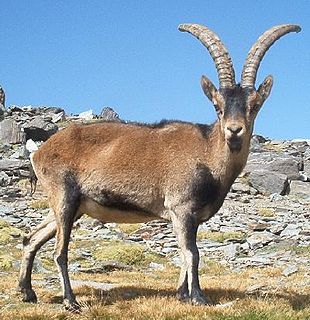 W
WThe Southeastern Spanish ibex or Beceite ibex is a goat that is endemic to Spain.
 W
WThe walia ibex is an endangered species of ibex. It is sometimes considered a subspecies of the Alpine ibex. Threats against the species include habitat loss, poaching, and restricted range; only about 500 individuals survived in the mountains of Ethiopia, concentrated in the Semien Mountains, largely due to past poaching and habitat depletion. If the population were to increase, the surrounding mountain habitat would be sufficient to sustain only 2,000 ibex. The adult walia ibex's only known wild predator is the hyena. However, young ibex are often hunted by a variety of fox and cat species. The ibex are members of the goat family, and the walia ibex is the southernmost of today's ibexes. In the late 1990s, the walia ibex went from endangered to critically endangered due to the declining population. The walia ibex is also known as the Abyssinian ibex.
 W
WThe West Caucasian tur is a mountain-dwelling goat-antelope native to the western half of the Caucasus Mountains range, in Georgia and European Russia. It is listed as Endangered on the IUCN Red List, as the wild population is estimated to be between 5,000 and 6,000 individuals.
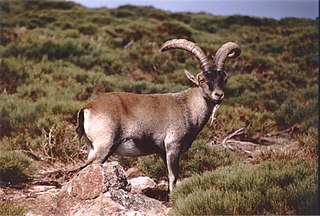 W
WThe Western Spanish ibex or Gredos ibex is a subspecies of Iberian ibex native to Spain, in the Sierra de Gredos. It was later introduced to other sites in Spain and to northern Portugal as a replacement for the extinct Portuguese ibex.
 W
WThe wild goat or common ibex is a wild goat species, inhabiting forests, shrublands and rocky areas ranging from Turkey and the Caucasus in the west to Turkmenistan, Afghanistan and Pakistan in the east. It has been listed as near threatened on the IUCN Red List and is threatened by destruction and degradation of habitat.